EUR/USD Eyes Key Support At The 1.0710 Level
sumber:
Belajar forex
The BoJ refreshed the global central bank discussion this past week after announcing negative rates. And, risk-oriented markets gained as they have in years past. Is this a return to familiar trends or a false dawn?
US Dollar Forecast – Dollar Hits a 12-Year High, But Can NFPs and Sentiment Maintain Lift?
The USDollar closed at a fresh 12-year high this past week. Yet, the occasion of breaching such exceptional heights has repeatedly disappointed over the past year.
British Pound Forecast – GBP/USD to Rebound to Succumb to Dovish BOE, Upbeat NFP Report
The Bank of England (BoE) interest rate decision is likely to heavily impact the British Pound next week with the central bank schedule to release its updated forecasts, and the near-term rebound in GBP/USD may continue to unravel should the Monetary Policy Committee (MPC) show a greater willingness to further delay the normalization cycle.
Japanese Yen Forecast – BoJ Makes Stealth Move to Negative Rates, Pressure on to China
Confidence is a pretty important thing in a financial system. After all, in a fiat-based monetary system, all that we really have is faith.
Australian Dollar Forecast –
Canadian Dollar Forecast – CAD Rally Stalls After Reversing Longest Losing Streak Since 1971
Steven Poloz’s refrain of a Bank of Canada rate cut that had become the preferred bet as the Loonie dropped brought a magnificent reversal for the CAD.
Chinese Yuan Forecast – Chinese Yuan Remains Stable Despite of BOJ Decision
The yuan offshore rate (CNH) moved little against the dollar this week, closing with a slightly bearish position on Friday.
Gold Forecast – Gold Boosted by Softer Fed Stance – Resistance at 1130
Gold prices are higher this week with the precious metal rallying nearly 1.8% to trade at 1117 ahead of the New York close on Friday.
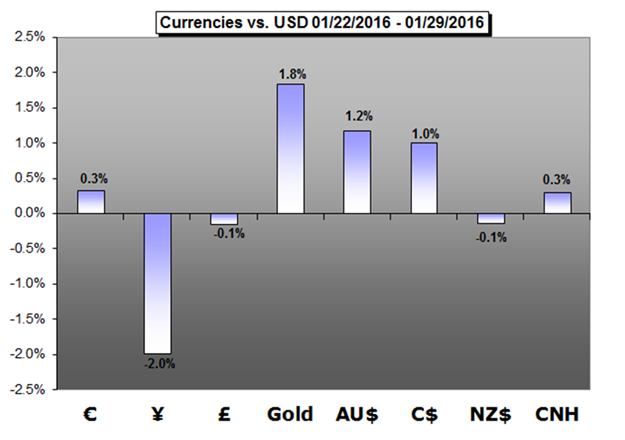
Sign up for a free trial of DailyFX-Plus to have access to Trading Q&A’s, educational webinars, updated speculative positioning measures, trading signals and much more!
What are the Traits of Successful Traders? See what our studies have found to be the most common pitfalls of retail FXtraders.
FITITOL–>
FXStreet (Córdoba) – In its statement on Wednesday, the Fed kept the door open to an interest rate rise in March, according to Esther Reichelt, analyst at Commerzbank, the USD is therefore becoming increasingly sensitive to the economic data. “A good labour market report next Friday should support the USD for now.”
Key Quotes
“At its January meeting, the Fed did not rule out an interest rate rise in March. The US dollar has not profited from this yet; US data and the situation on equity markets this year have so far given the market more reason to expect a rate pause in March. And the market remains cautious. Besides lasting calm on global financial markets, solid US economic data are a necessary prerequisite for the market to see any chance at all of a rate step in March.”
“However, the more bullish the upcoming data publications are, the more likely a move on rates should become and the stronger the US dollar should become. Against this backdrop, the data heavyweights due for publication in the week ahead should be able to offer the US dollar support initially.While the ISM index for manufacturing is expected to remain weak in next Monday’s release, it should have improved a little on December.”
“Ultimately however, all eyes will be on the labour market report on Friday, as the Fed gave the labour market a prominent place in its communiqué last Wednesday. Catch-up effects in wage growth in particular could lend impetus to the US dollar as the Fed needs urgent signs that inflation pressure is rising. However, this will probably not be enough to break out of the EUR/USD trading range of 1.0750-1.10 that has formed since the beginning of the year. The FX market is too cautious for that given the still moderate outlook.”
FITITOL–>
FXStreet (Córdoba) – Analysts from Wells Fargo affirmed that after 4Q real GDP, there is no case for a Federal Reserve rate hike in March; but they noted some positive signs from the report.
Key Quotes:
“Real GDP rose at a 0.7 percent annual pace in the fourth quarter following a 2.0 percent rate in the third quarter. It is worth noting that since the 1980s, real GDP has trended lower—a signal of a changing framework for the economy.”
“There is some positive news in the report. Real final sales to domestic purchasers, which excludes inventories and trade, rose at a 1.6 percent pace following a 2.9 percent increase in the second quarter.”
“Consumer spending remains a positive force with the support of improving labor market conditions and stronger purchasing power due to the decline in retail gasoline prices.”
“In the fourth quarter, overall inflation came in at 0.8 percent with sharp declines in export and import prices. The Fed’s benchmark PCE deflator came in at just 0.1 percent with both durable and nondurable prices registering a decline, but services up at a 2.0 percent pace.”
“Given the modest real GDP gain and continued low inflation, we see no case for a Fed rate hike in March. For the year we still have overall PCE inflation remaining below 2 percent.”
Spesifikasi Oppo F1 Plus, Ponsel 4G Premium Dukung Mesin Octa Core Gahar – Tak selang berapa lama setelah merilis seri F1 untuk para penggila selfie, Oppo kini meluncurkan teaser dari penerus seri F1 yakni F1 Plus. Berdasarkan kabar yang beredar, spesifikasi yang ditawarkan oleh seri Oppo F1 Plus ini bisa dibilang hampir setara dengan spesifikasi dari F1 standar. Vendor asal China tersebut juga telah mempersenjatainya dengan layar sentuh yang lebih lega dan RAM berkapasitas 4GB. Jelas, peningkatan spesifikasi yang signifikan dari seri sebelumnya F1. Seperti yang dikutip dari GSM Arena (27-01-2016).
Ponsel pintar besutan Oppo ini menawarkan layar sentuh seluas 5,5 inci dengan teknologi panel IPS (In-Plane Switching) kapasitif yang beresolusi full HD 1080 x 1920 piksel dengan kepadatan layar mencapai 401 piksel per inci, serta telah dilindungi oleh kaca lengkung 2,5D dari Gorilla Glass4, jelas spesifikasi layar yang mantap. Seri Oppo F1 Plus ini dipastikan sudah mendukung sistem operasi Android 5.1 Lollipop dengan balutan antarmuka khas ColorOS 2.1.

Kamera merupakan fitur unggulan yang ditawarkan oleh Oppo F1 Plus, karena sang vendor telah membekalinya dengan kamera utama beresolusi 13MP autofocus dengan sensor BSI (BackSide Illumination), phase detection, aperture f/2.2 dan didukung LED flash. Selain itu, Oppo F1 Plus juga sudah dibekali dengan kamera depan beresolusi 8MP dilengkapi fitur Flash screen yang sangat pas untuk anda yang gemar foto selfie dan video call.
Kinerja yang dihadirkan oleh Oppo F1 Plus ini tidak jauh beda dengan seri R7s dengan mengandalkan dukungan chipset Qualcomm Snapdragon 616 yang mengadopsi prosesor octa core ARM Cortex-A53 64-bit yang terdiri dari quad core 1GHz dan quad core 1,7GHz yang dikolaborasikan bersama RAM 4GB dengan dukungan pengolah grafis mumpuni dari Adreno 405.
Smartphone besutan Oppo ini telah didukung dengan memori internal berkapasitas sebesar 16GB yang masih dilengkapi fitur slot microSD mencapai 128GB. Oppo F1 Plus juga telah didukung fitur jaringan lengkap, sebut saja dual SIM, 4G LTE, Bluetooth, 3G HSPA, port microUSB, GPS, Wifi, audio jack 3,5mm, dan FM Radio. Untuk daya, smartphone ini sudah didukung dengan kapasitas baterai sebesar 2500mAh lengkap dengan fitur VOOC fast charging.
FITITOL–>
FXStreet (Córdoba) – There will be no change to the MPC’s monetary stance at next week’s “Super Thursday” meeting but there will be some interest surrounding the voting stance of Ian McCafferty, the Committee’s only dissenter, who has been voting for a 25 bps increase since August, according to Peter Dixon, analyst at Commerzbank.
Key Quotes
“The message from Mark Carney is that wage costs are not picking up sufficiently to justify policy action in the near term, undermining Mr McCafferty’s position which has been based on fears of rising labour costs.”
“The BoE continues to express concern that productivity growth remains weak, with MPC member Kristin Forbes indicating that the Q4 figures could be ‘abysmal’.”
“However, weak price inflation will take some of the heat out of wage growth and prevent wage and productivity figures from moving too far out of line in the near-term. Accordingly, the majority view of no change will prevail for some months to come, and we continue to look for the first move on rates only towards the end of the year”.
“The other item on the agenda next week will be the release of the Inflation Report which will give the BoE the opportunity to update its economic forecast. It is possible that the 2016 GDP growth and inflation forecasts will be shaded down modestly although this is unlikely to materially affect the bank’s thinking.”
China is upset ’cause a US naval ship has sailed through its waters. Turkey is upset ’cause a Russian fighter jet violated its airspace.
– A U.S. Navy destroyer sailed within 12 nautical miles of an island claimed by China and two other states in the South China Sea on Saturday … China’s foreign ministry condemned the action. ()
Geopolitics never goes away. The Russia / Turkey incident follows the shooting down of a Russian fighter jet
FITITOL–>
FXStreet (Córdoba) – US stocks rallied on Friday and closed the week with gains, but despite the recent recovery, the main indexes ended the month with heavy losses following steep declines during the first weeks of the year.
US stocks soared on Friday after the Bank of Japan unexpectedly cut rates into negative, to -0.1%, also helped by a modest recovery in oil prices.
The Dow Jones Industrial Average gained 394.45 points, or 2.47%, to 16,466.09 and posted a 2.3% weekly gain. The S&P 500 rose 46.65 points, or 2.48%, to 1,940.02 and closed the week 1.7% higher but lost 5% over the month. The Nasdaq Composite climbed 107.28 points, or 2.38%, to 4,613.95 and finished the week virtually unchanged.
But what was the risk?
My nephew’s 8th grade basketball team (think 13-14 years old) was playing in the championship game for the league last night. The team they were playing they lost to earlier in the season, but they were closely matched. The score was tied with a few seconds left. My nephew’s team had the ball.
Fundamental Forecast for CAD: Bearish
Steven Poloz’s refrain of a Bank of Canada rate cut that had become the preferred bet as the Loonie dropped brought a magnificent reversal for the CAD. However, toward the end of the week, the CAD rally stalled and CAD-crosses looked to oil for direction. For a majority of the week, a ‘Dash for Trash’ in Oil assets seemed sustainable as news of a coordinated global oil production cut appeared in the making. However, on Thursday, the news became obvious that such a plan was unlikely to develop, and the elusiveness of such a plan made Oil and, therefore, CAD unable to hold gains. One oil trader, Gerrit Zambo of BayernLB stated, “Don’t think there are many experienced people that really think Russia or Saudi Arabia would considerably cut production as long as they have the possibility to sell into the market,”
Suggested Reading: Oil Collapse Driven by Panic; Is CAD at a Policy Turning Point?
The Canadian economy did show growth for the first time in three months when the government released GDP on Friday morning showing 0.3% MoM. This growth was a glimmer of good news because the global economy continues to show weak growth. A notable print last week was the pitiful durable good number in the United States that showed a 5.1% drop in orders for durable goods. This poor print affirmed the U.S. manufacturing sector susceptibility to global headwinds.
Next week, we’ll have two key points to take the temperature of the Canadian economy in an environment where commodities remain at depressed prices. Canadian Manufacturing PMI & Unemployment will be looked at to see if there is a sense of positive momentum from the GDP print last Friday.
From a sentiment perspective, we’ve seen traders through our speculative sentiment index or SSI fighting the latest move as USD/CAD has dropped. This move represents a substantial shift in retail forex trader positioning, which warns that the USD/CAD may have set an important top. Our data shows there are currently 1.3 open retail short positions in the USD/CAD for every one that is long; 43% of traders are long. As you can see on the # of bullish & bearish orders below, this represented a notable swing from three weeks ago when that ratio exceeded 4 to 1.
 The past trading week was marked with several policy meetings of major central banks. The most interesting of them turned out to be the Bank of Japan meeting that resulted in a surprise cut of interest rates into negative territory. As one can expect, this resulted in a slump of the Japanese yen.
The past trading week was marked with several policy meetings of major central banks. The most interesting of them turned out to be the Bank of Japan meeting that resulted in a surprise cut of interest rates into negative territory. As one can expect, this resulted in a slump of the Japanese yen.
Not many market participants had expected Japan’s central bank to reduce rates, thinking that it would rather tweak its assets purchase program or implement other form of stimulus if any at all. Yet the BoJ surprised virtually everyone, announcing negative interest rates and sending the yen crashing against other most-traded currencies.
Among other important events were the meetings of the Federal Reserve and the Reserve Bank of New Zealand. The Fed issued cautious statement, making the US dollar weaker against most other currencies. The RBNZ made no changes to its policy as well, but talked about possibility of interest rate cuts in the future.
USD/JPY rallied 1.9 percent from 118.64 to 121.06 over the week. EUR/JPY climbed 2.2 percent from 128.05 to 131.15. NZD/JPY gained from 77.02 to 78.37.
If you have any questions, comments or opinions regarding the Japanese Yen,
feel free to post them using the commentary form below.
Fundamental Forecast for Yen:Neutral
Confidence is a pretty important thing in a financial system. After all, in a fiat-based monetary system, all that we really have is faith. There’s no gold or silver backing the currency, and while I’m not saying that’s a ‘good’ thing since pretty much all of those regimes have failed, faith is of utter importance because, should trust wane investors may just sell out of your currency at an uncontrollable pace. This could lead to significant currency weakness as investors flock to anywhere but your currency, and all of those goods that you have to import all of the sudden begin to get very, very expensive. This is one of the reasons that negative rate-regimes have been avoided for so long: It could be potentially playing with fire (the inflationary kind). And this inflation isn’t of the ‘healthy’ variety. Just ask Russia. This even began to show signs in Canada earlier this week with reports of the Great Cauliflower Crisis; where four simple heads of Cauliflower could buy a full barrel of Oil. But this isn’t about cauliflower; we’re talking about history here.
The Bank of Japan shocked pretty much everybody watching last night by pulling rates into negative territory. I’m not aware of anyone that saw this coming or even thought of it as being a possibility. As a matter of fact, until a leak hit news wires in Japan just ahead of the announcement, the prospect of negative rates had been seemingly eliminated by the man at the top of the BoJ himself, Mr. Haruhiko Kuroda, just two weeks ago. Just before flying to the World Economic Forum in Davos, Mr. Kuroda told Japan’s parliament that he wasn’t even considering negative rates. And this made sense: Even at the lows of this thus far painful year, as panic was at an apex, the Yen was still 54% weaker against the US Dollar compared to the pre-Abe highs. And while Japan was still far from ‘turning the corner’ on the inflation front, the case could be made that they were in a significantly more handsome position than many other economies in the world.
But Japan saw this as a big threat apparently. After ‘Abe-nomics’ really only provided relief in the form of exchange rates, growing risk aversion around the world exposed the Yen as a prime candidate for safe-haven flows. As investors ran out of riskier investments and riskier currencies, the seeming safety of a developed Japan could be a really attractive draw, even if rates were next to zero. In panics, the onus is on return OF capital, not return on capital. But that was effectively nullified last night by Japan’s move to sub-zero rates. Now staying long Yen actually costs money. Being short Yen pays (theoretically), and further to the point, there are quite a few more reasons for Japanese businesses to employ that stored capital. So, by design, negative rates could help; it’s just that we don’t have any evidence that they actually do. The only case study of a major economy going negative is Europe and, well; let’s just say that shouldn’t serve as a positive example of anything yet. Outside of that we have Denmark’s example of going negative, but that’s not really a relevant comparison considering the disparity in sizes between the two economies.
So, this is a gigantic experiment that could potentially have very, very ugly consequences. There is no compelling reason to be long of the Yen until something significant changes. Safe-haven flows should be directed elsewhere, as the threat of even deeper-negative rates could create additional drag on risk-aversion flows. Mr. Kuroda warned last night, he will go more negative if he has to.
But there’s another factor here; because economies don’t exist in vacuums. China is in a fairly precarious state at the moment. China and the US are basically tied for the top export destinations for Japan ($133B and $134B respectively), and this move by the BoJ just put pressure directly on both of those trade partners. Now Japanese products are going to be more attractive in these economies, and their respective products (Chinese and American) will be less attractive in Japan. This is not going to help China, and this may serve as just another crimp on growth in an already vulnerable American economy as flows move from Japan to the US. This may even be the type of provocative move that could create ire in Chinese media sources and throughout the Chinese economy.
The problem in China is debt, and frankly they need a weaker currency to help boost exports so that they can a) continue servicing debt b) continue to grow at a pace that will allow that 280% debt-to-gdp ratio to come down to a more palatable level over the next 10-20 years and c) continue growing a middle class so that the country can decrease its brutal reliance on exports because, as Japan just showed us, being an export-based and driven economy just makes you vulnerable to global trade winds.
As the Yuan strengthens, that makes all of this just that much more difficult, and with Japan now going negative on deposits, that just drives more trade flows into the Yuan. And a stronger Yuan is pretty much bad for the entire world right now as Chinese products get more expensive internationally, and less comes back to China in the form of Yuan. For China, the timing of this move couldn’t be worse. Fully expect China to respond, in some way. Chinese media was noticeably quiet last night, and this is normal in such situations as the state still controls (and authorizes) what the media can say about such matters. But we’ll have a report on that this Monday that should include some interesting weekend reading from Chinese-language sources.
For now – avoid long Yen. And even short Yen may be daunting considering that we’re just waiting on a response from China. But this may be a relevant option to mesh up with any currencies that you might actually want to buy. There isn’t much out there in that department not named the US Dollar right now, given that most major economies are already at or near-zero rates and expecting to stay there for a while.
This event is still far too fresh to move our forecast into bearish territory. We need to see more than one day of continuation before saying that this is a long-lasting theme.
One interesting idea should Yen weakness prove that it can hold could be a fairly flexible carry trade: Short Yen/Long Stocks. This was somewhat of the motive for that massive EUR/USD move last year after Europe went negative. Sell Euros for Dollars and then use those dollars to buy US stocks. This is what sent the S&P to its all-time-high and the strategy was fairly widely-followed but began to get nullified as Greek worries piped up again last spring, and the risk of a Euro break-up made that carry trade not-all-that-attractive any longer. There are a lot of ‘ifs’ to the potential execution of such a strategy in the current environment, and that’s somewhat indicative of the issue that we’re talking about. IF stocks continue to show the same strength as the past two weeks and IF China’s pain moderates, we could see risk aversion wane and that could make for an accommodating environment for the carry. Until then, there is a ton of risk and a lot of unknowns.
Until then, be careful of being long of the Yen. It is now a costly endeavor.
Final revisions to the consumer sentiment report from the University of Michigan:
– The preliminary report was at 93.3 vs 93.0 expected
– Prior was at 92.6
– Current conditions 106.4 vs prior 105.1 prelim and 108.1 prior
Consumers are feeling pretty good about the current outlook but less certain about the future.
Kaplan interview with Reuters:
–
Fed has not downgraded forecasts but needs to understand the effects on US
– It’s ‘significant’ that the Fed removed the reference to ‘balanced’ risks in the statement
Dovish stuff from Kaplan as the Fed begins The Great Climbdown. It’s like they’ve finally seen headwinds that everyone warned them about but in December they were so fixated on that first hike that they missed all the signals.
Spesifikasi Gionee Marathon M5 Mini, Ponsel 5 Inci HD Dukung Baterai 4000mAh – Setelah sebelumnya sukses dengan varian M5 Enjor dan M5, kini Gione kembali ingin mengulang kesuksesannya tersebut dengan mengeluarkan produk smartphone anyar melalui Marathon M5 Mini. Keunggulan smartphone anyar besutan Gionee ini adalah adanya dukungan baterai berkapasitas jumbo dikelasnya. Seri Gionee Marathon M5 Mini ini akan pertama kali dirilis dinegara Nigeria. Sayangnya, kami belum mengetahui berapa bandrol harga yang ditawarkan oleh seri Marathon M5 Mini ini.
Untuk layar, smartphone besutan Gionee ini menawarkan ukuran layar seluas 5 inci dengan dukungan teknologi panel IPS (In-Plane Switching) kapasitif beresolusi HD 1280 x 720 piksel dengan ketelitian layar mencapai 294 piksel per inci (ppi), setara dengan para pesaing dikelasnya. Ponsel Gionee Marathon M5 Mini ini sudah mendukung sistem operasi Android 5.1 Lollipop dengan balutan antarmuka khas Gionee.

Diarea dapur pacu, smartphone besutan Gionee ini telah dibekali dengan hardware yang cukup mumpuni seperti prosesor quad core ARM Cortex-A7 dengan kecepatan 1,3GHz, RAM sebesar 2GB, chipset MediaTek MT6580 dan pengolah grafis Mali-400MP2. Kinerja yang dihasilkannya bisa dibilang setara dengan para pesaingnya. Seperti yang dikutip dari GSM Arena (27-01-2016).
Pihak Gionee sendiri telah membekalinya dengan memori internal sebesar 16GB yang masih bisa anda perbesar lagi hingga 32GB dengan memanfaatkan slot microSD yang telah disediakan didalamnya. Selain itu, smartphone Gionee Marathon M5 Mini ini juga telah dibekali dengan fitur jaringan dan konektivitas yang cukup lengkap, sebut saja 3G HSPA, Bluetooth, GPS, 4G LTE, dual SIM, Wifi dan port microUSB.
Kamera yang ditawarkan oleh Gionee Marathon M5 Mini ini bisa dibilang sudah lebih dari cukup, dengan mengandalkan kamera belakang berkekuatan 8MP yang dibekali LED flash dan autofocus, serta dukungan dari kamera depan dengan kekuatan 5MP yang siap memanjakan anda yang gemar berfoto selfie dan video call. Semua fitur dan kinerjanya itu disandarkan pada baterai berkapasitas 4000mAh yang mampu bertahan selama 2 hari pemakaian.
Oil and gas drilling data from Baker Hughes:
– Prior was 510
– Gas rigs 121
– Prior gas rigs 127
– Overall rigs 619 vs 637 prior
Oil rigs have been running off for more than a year but production has hardly slowed. With massive builds continuing in the US and storage overflowing, it will take awhile to run-down the excess and get the market into balance; but crude hitting $26 this month will speed things up.
Fundamental Forecast for the Yuan: Neutral
The yuan offshore rate (CNH) moved little against the dollar this week, closing with a slightly bearish position on Friday. China’s central bank held the reference rate steady and guided the daily rates in a tight range between 6.5516 and 6.5557. Bank of Japan’s unexpected decision to move rates to negative territory added volatility across the currency market. However, as China has just made multiple announcements to warn against Yuan Short speculation, we expect in the coming week that the reference rate will remain tight, and both the onshore (USD/CNY) and offshore (USD/CNH) yuan rates will remain rather firm. Chinese January PMI and Caxin PMI figures to be released next week will be the key event drivers to the Yuan.
Japan, one of China’s most important trade partners, surprisingly announced negative interest rates on Friday. The CNH/JPY surged to 18.3130 from 17.9327 following the decision. The timing of this cut is tough for China. While it may release some tension in Chinese stocks– the Shanghai Composite Index gained 3.09% on Friday after it dropped for three consecutive days; this can be troubling news for China. A cheaper Yen, or say a more expensive Yuan, means that Chinese products become more expensive on a relative basis. This will put additional pressure on China’s already weak exports. Of specific focus, major equipment products that China sells to Japan are highly labor intensive such as electronic equipment, machines and clothing. The price elasticity of those products is high; meaning the demand on those products can be reduced significantly due to higher prices. The Chinese government will not need to devalue the currency; a weakened export condition will eventually drive the yuan lower, in the long run.
In terms of the short-term impact of BOJ’s rate cuts to financial markets, this will drive capitals flows out of Japan to other markets, including China. Thus, we may see some improvements in Chinese stocks due to this move to negative rates, but the benefit is limited as China’s capital market is not yet fully opened.
Also, as we have discussed in previous weeks, the performance of Chinese equity markets constrains the Yuan’s floating range – no two fires in the same house at the same time. So normally, when a crisis in the stock market is seen as being managed, regulators’ controls on the Chinese yuan should be relaxed as well. However, in the past week, Chinese state media and officials sent out messages that “China has no intention to devalue the currency or start a trade war”, it is less likely that they switch the tone immediately in the coming week even if the equity market is improved or after its neighboring trade partner adopts an aggressive stimulus policy. Thus, the Chinese Yuan is likely to stay relatively stable in the next weekly session.
In addition to the above themes, China’s January PMI figures to be released in next week are worth keeping an eye on as well. Remember, the December Caixin PMI ratio was the trigger to the most recent plunges in Chinese stocks. As of today, the Shanghai Composite has dropped by -22.6% in a month, the largest monthly drop in over 8 years. Of course, the PMI reading itself was not the sole contributor to that move, but it has likely become a major driver of sentiment. In a market with 80% of transactions made by retail investors, many rely more on news and rumors than on solid information and analysis, and as the old saying goes – once bitten, twice shy.
Overall, the Chinese yuan in the next week should remain relatively stable. However, the hidden pressure from BOJ rate cuts may be released over a longer period of time.
—Subscribe to Jamie Saettele’s distribution list in order to receive a free report to your inbox several times a week.
—For more analysis and trade setups (including current positions and the ‘watchlist’), visit SB Trade Desk
Weekly
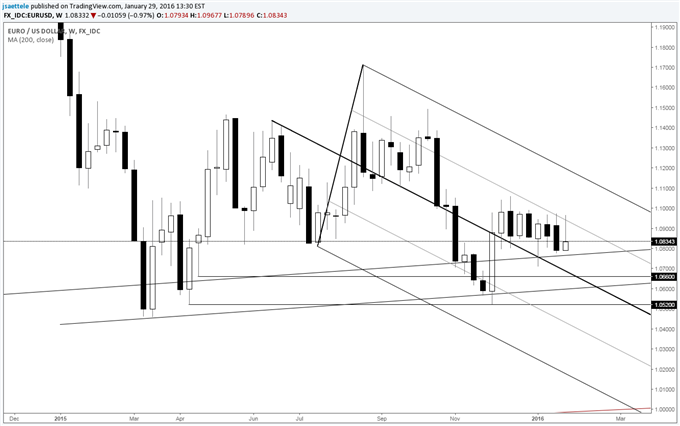
Chart Prepared by Jamie Saettele, CMT
Automate trades with Mirror Trader
-Long term comments remain valid – “EUR/USD has been holding its long term trendline support since March 2015 (even the January low is right on the line). November and December trade produced a tweezer bottom (reversal candlestick pattern…bullish in this case) as well. 2 scenarios seem most likely from the current juncture; a continued range (with roughly 1.15 resistance) or a bullish base that leads to an eventual breakout into the 1.20s.”
-Near term, FXTW suggests watching for support on the shorter term median line (bold black line on the chart above) in the mid-1.0600s. The market has been in a tight range since December (in fact, this is the tightest 8 week range since August 2015, when a major breakdown began). Such conditions aren’t conducive to SSI breakout strategies. However, ranges precede directional moves so pay attention to key technical breaks.
-For forecasts and 2016 opportunities, check out the DailyFX Trading Guides.
GBP/USD
Weekly
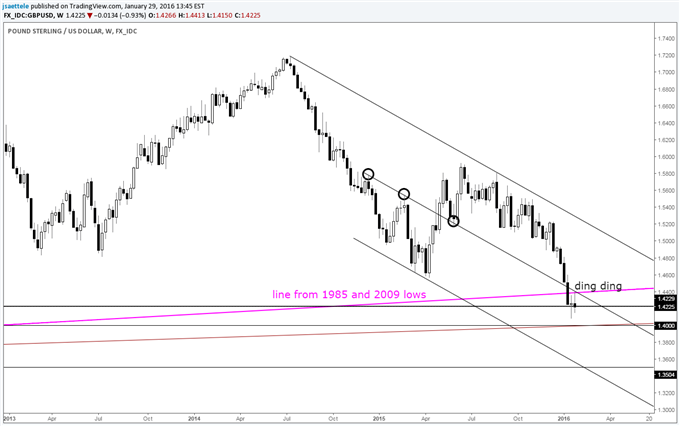
Chart Prepared by Jamie Saettele, CMT
Automate trades with Mirror Trader
-FXTW wrote last week that “cable bounced higher this week but price needs to establish above 1.4400 (see trendline confluence on the chart) in order to suggest that even a short term low is in place.” The underside of the 1985 and 2009 line (which broke 2 weeks ago) and an internal trendline provided precise resistance for downside continuation. The next area of interest on the downside is around 1.40.
AUD/USD
Weekly
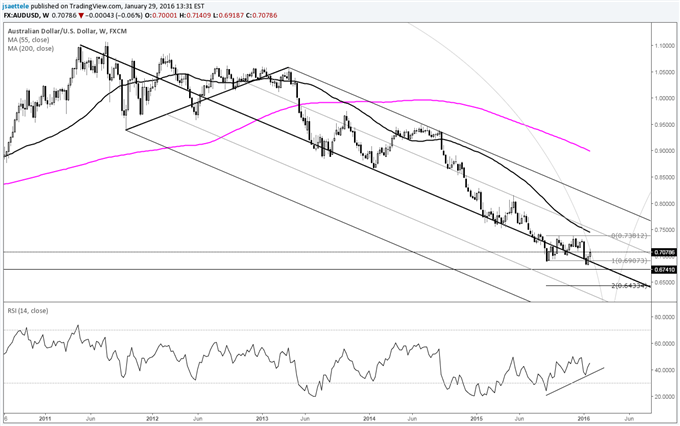
Chart Prepared by Jamie Saettele, CMT
Automate trades with Mirror Trader
-FXTW wrote last week that “corrective (range bound) trading behavior may very well continue given this week’s tweezer bottom (at the long term median line no less). Divergence with RSI on the weekly serves as a bullish reversal warning too.” AUD/USD followed through on the tweezer bottom this week and the short term charts ‘look’ constructive. If the USDOLLAR is grinding into some sort of top (see a video on this here), then AUD/USD may be the play.
Weekly
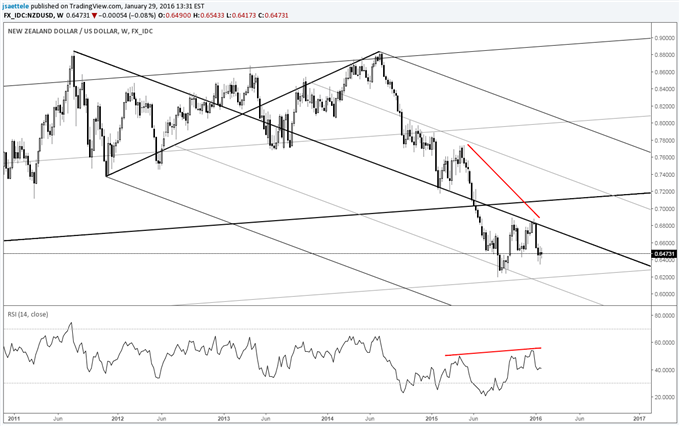
Chart Prepared by Jamie Saettele, CMT
Automate trades with Mirror Trader
-NZD/USD was quiet this week and there is no change to prior comments. “The October and December highs create a double top within the longer term downtrend. The red lines on the chart indicate a long term RSI trend sell signal (higher RSI and lower price). The October high remains critical to any bearish interpretation. Like AUD/USD, a period of range trading may be in store given the recovery from under the November low.”
USD/JPY
Monthly
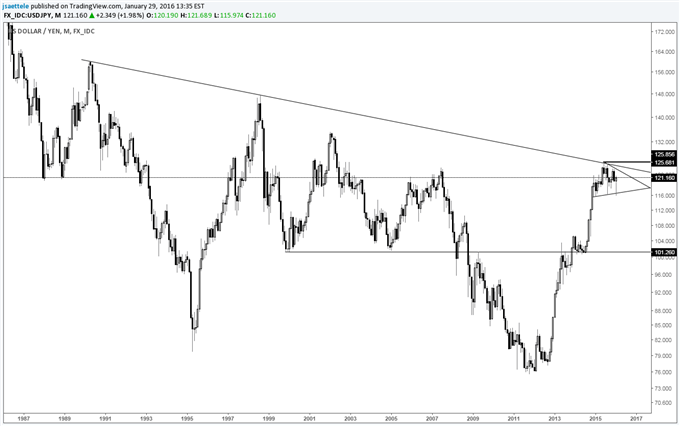
Chart Prepared by Jamie Saettele, CMT
Automate trades with Mirror Trader
-FXTW has been following a possible head and shoulders top that started forming in December 2015. Last week’s reversal materialized from the neckline of that pattern. This week’s follow through has resulted in a test of the 55 week average. The 2015 high was right at the 1990-1998 line (log scale), so a broader topping formation is still possible.
Monthly
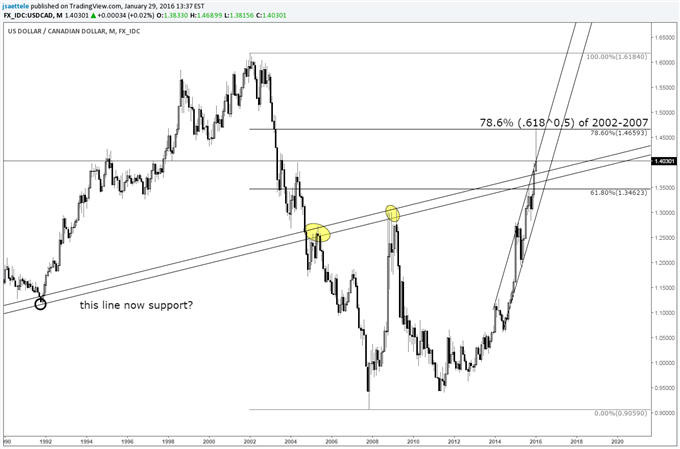
Chart Prepared by Jamie Saettele, CMT
Automate trades with Mirror Trader
-The most recent FXTW comments were that “extremely long term slope analysis reveals that the 1976-1991 line, which was resistance (not precise however), could end up as support again on the next ‘correction’. That line is around 1.3600. If USD/CAD is going to ‘correct’, which might it correct from? At this point, I’d watch the 78.6% retracement of the decline from the 2002-2007 decline. The Fib is 1.4659.” The high this month was 1.4689 and USD/CAD has reversed sharply. A top of some importance could be in place.
Weekly
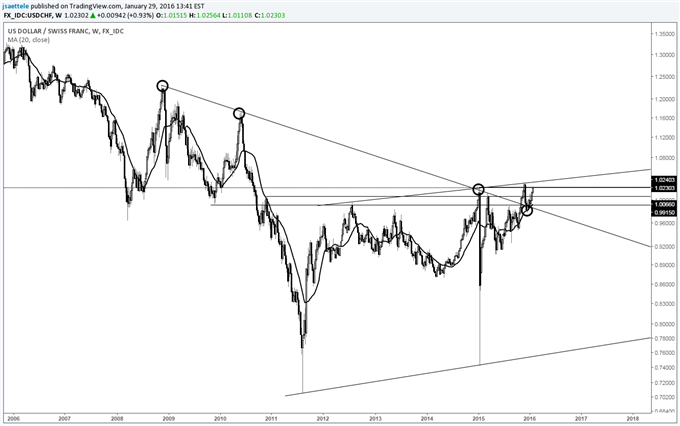
Chart Prepared by Jamie Saettele, CMT
Automate trades with Mirror Trader
-Some extremely long term technical considerations are worthy of note when looking at USD/CHF. Read about them here. This week’s advance brings the cross less than 2 big figures away from multiyear highs so another breakout attempt (first one was in November) may be near.
Forex news for January 29, 2016
Markets:
– Gold up $2 to $1117
– WTI crude up 42-cents $33.64
– US 10-year yields down 5 bps to 1.93%
– CAD leads, JPY lags badly
A big question midway through the month was if central banks ‘get it’. That doesn’t explain all the worries in markets (commodities, China, especially) but it’s an important part of the equation. In the past 8 days, the ECB, Fed and BOJ have all delivered a more dovish tone.
Overview
The silver price declined strongly yesterday, breaking the 14.27 level, and has settled at a daily close below it. This stops the positive overview suggested in our recent reports and puts the price inside the sideways range again, waiting to breach one of the lines represented by the 13.65 support and 14.40 resistance to detect the next targets clearly. Therefore, the sideways trading will remain dominant on an intraday basis. Breaching the 14.40 level will reactivate the correctional bullish scenario, which next target is 15.30; while breaking the mark of 13.65 will resume the main bearish trend, which targets begin at 13.00 and extend to 12.00.
The expected trading range for today is between the 13.80 support and 15.67 resistance.
| ||
Performed by Hossam Soliman Ali, Analytical expert InstaForex Group © 2007-2016 |
One more surprise to end a wild month
In Davos, Bank of Japan Governor Kuroda played down worries in the economy.
"At this stage, a virtuous cycle of income to spending by the corporate sector as well as the household sector is maintained — fairly robust," Kuroda said last weekend. "We are not so much concerned about the real economy."

<!–
GBPJPY, 4 Hour
Within the GBPJPY 4 hour chart I am spotting the potential development of a basic Elliott Wave 5 wave sequence. See (1), (3) and the possible (5?) impulse waves, with the corrective waves being (2) and the possible (4?).
My strategy for this trade consists of two trades broken down in two parts. Trade 1 of part 1 is to short the pair till price is within my “Go Long Zone” (see above chart) 1st target , at that point I will reverse my short trade into a long position (trade 2 of part 2) for a 2nd target within the “Target Zone “ as indicated in the above chart.
Want to learn to trade and analyse the markets? Join our webinars and get analysis and trading ideas combined with better understanding on how markets work. Click HERE to register for FREE! The next webinar will start in:
Senior Currency Strategist
HotForex
Disclaimer: This material is provided as a general marketing communication for information purposes only and does not constitute an independent investment research. Nothing in this communication contains, or should be considered as containing, an investment advice or an investment recommendation or a solicitation for the purpose of buying or selling of any financial instrument. All information provided is gathered from reputable sources and any information containing an indication of past performance is not a guarantee or reliable indicator of future performance. Users acknowledge that any investment in FX and CFDs products is characterized by a certain degree of uncertainty and that any investment of this nature involves a high level of risk for which the users are solely responsible and liable. We assume no liability for any loss arising from any investment made based on the information provided in this communication. This communication must not be reproduced or further distributed without our prior written permission.
January 29, 2016: The
The strongest currency is the NZD today. The weakest is the JPY. Japan adopted a negative rate policy and that spiked the USDJPY straight to the upside. The high reached just short of the 200 day MA at 121.45 (my high comes in at 121.383, Bloomberg comes in a few pips higher). The strongest currency is the NZD and the AUD. The strength in those currencies is centered vs the JPY. The changes vs. the dollar are fairly contained. The greenback is higher as well today- doing better against all currencies with the exception of the NZD. Today the US GDP will be released at 8:30 AM with the estimate at 0.8%. Personal consumption – 70% of so of GDP is consumption – is expected to rise 1.8%.